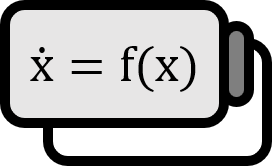Neimark-Sacker Bifurcation
Definition
Simple Definition
Neimark-Sacker Bifurcation is a bifurcation in which an invariant closed curve arises or disappears at a fixed point as a parameter changes in a dynamical system1.
Complex Definition
Let’s denote $n \ge 2$. $$ \dot{x} \mapsto f \left( x , \alpha \right) \qquad , x \in \mathbb{R}^{n} , \alpha \in \mathbb{R}^{1} $$ Given that the dynamical system $f$ is smooth under $x$ and $\alpha$. Suppose $\bar{x}$ is the hyperbolic fixed point of the system, and let $D f \left( \bar{x} \right)$ be the Jacobian matrix of this system. Among the eigenvalues of $D f \left( \bar{x} \right)$, let us denote two of them as $\lambda_{k_{1}}$ and $\lambda_{k_{2}}$. The bifurcation related to the existence of $\lambda_{k_{1}, k_{2}} = \exp \left( \pm i \theta \right)$ for $0 < \theta < \pi$ is called Neimark-Sacker Bifurcation2.
Normal Form
$$ \begin{align*} \theta =& \theta (\alpha) \\ a =& a (\alpha) \\ b =& b (\alpha) \\ d =& d (\alpha) = a + i b \\ c =& c (\alpha) = e^{i \theta} d (\alpha) \\ \mu =& \mu (\alpha) = \left( 1 + \alpha \right) e^{i \theta} \\ R_{\theta} =& \begin{bmatrix} \cos \theta & - \sin \theta \\ \sin \theta & \cos \theta \end{bmatrix} \end{align*} $$ From now on, we assume that the parameters mentioned below are functions dependent on the key parameter $\alpha$ and that $R_{\theta}$ represents the rotation matrix. Suppose the complex number $z$ is expressed as $z = x + iy$, or in polar coordinates as $z = r e^{i \phi}$. The Neimark-Sacker bifurcation can be classified into two types: supercritical and subcritical, denoted as supercritical when $a(0) < 0$ and subcritical when $a(0) > 0$. Both types share the following normal form:
In Cartesian coordinates: $$ \begin{bmatrix} x \\ y \end{bmatrix} \mapsto (1 + \alpha) R_{\theta} \begin{bmatrix} x \\ y \end{bmatrix} + \left( x^{2} + y^{2} \right) R_{\theta} \begin{bmatrix} a & -b \\ b & a \end{bmatrix} \begin{bmatrix} x \\ y \end{bmatrix} $$ In the complex plane: $$ z \mapsto e^{i \theta} z \left( 1 + \alpha + d \left| z \right|^{2} \right) = \mu z + c z \left| z \right|^{2} $$
Diagram
- supercritical: Let $\alpha$ increase gradually. In $\alpha \le 0$, $z = 0$ was a stable node, but in $\alpha > 0$, $z = 0$ changes to an unstable node, and a stable invariant closed curve arises.

- subcritical: Let $\alpha$ decrease gradually. In $\alpha \ge 0$, $z = 0$ was an unstable node, but in $\alpha < 0$, $z = 0$ changes to a stable node, and an unstable invariant closed curve arises.

Explanation
Neimark-Sacker bifurcation, also sometimes referred to as torus bifurcation, is not a phenomenon that is easily encountered, but it can be seen as an analog to the Hopf bifurcation in discrete systems. Thus, it is good to be familiar with its name.
See Also
- Hopf Bifurcation: Can be seen as the Neimark-Sacker bifurcation in continuous systems.
http://www.scholarpedia.org/article/Neimark-Sacker_bifurcation ↩︎
Kuznetsov. (1998). Elements of Applied Bifurcation Theory: p114. ↩︎
